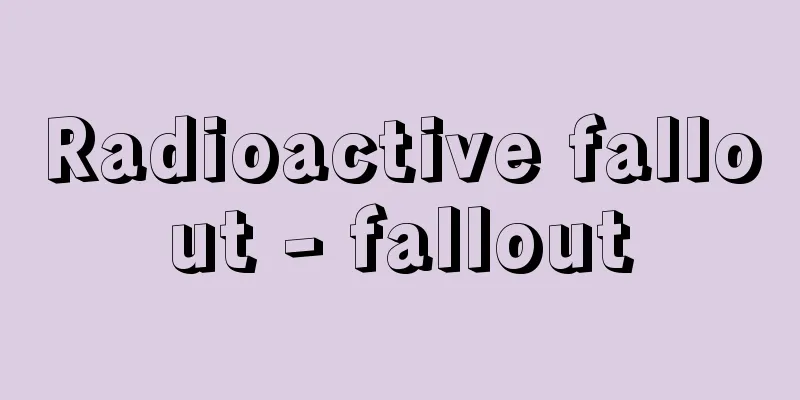Radioactive fallout - fallout

|
Radioactive material in the atmosphere that falls to the ground. There are three sources: (1) natural releases, (2) nuclear weapon explosions, and (3) radioactive material and fission products from nuclear power plants. Most of the radiation in the atmosphere comes from cosmic rays and radon gas that diffuses from natural uranium and thorium in the earth's crust. Radioactive materials that originate from cosmic rays include radioactive carbon and radioactive hydrogen. Radioactive fallout from a nuclear explosion is divided into three types: local fallout, tropospheric fallout, and stratospheric fallout. Local fallout is large radioactive material that falls near the site of the explosion and emits strong radiation but has a relatively short lifespan. Tropospheric fallout is fine radioactive material that remains in the troposphere before falling and is dispersed over a wide area depending on weather conditions. It often falls in areas at the same latitude as the explosion site for one month after the nuclear explosion. Stratospheric fallout consists of very fine particles that reach the stratosphere, can continue to fall for years, and are distributed over almost the entire world. It occurs only when large nuclear weapons are detonated. Radioactive material from the stratosphere eventually moves to the troposphere and falls to the Earth's surface by gravity, electrical attraction, or by attachment to larger particles such as raindrops. Many types of radioisotopes are formed by nuclear explosions, but only the long-lived isotopes reach the stratosphere and fall out. Examples are cesium-137 (half-life 30 years) and strontium-90 (half-life 28 years). Strontium-90 has chemical properties similar to calcium and can therefore accumulate in the body through food, posing a serious risk to human and animal life. Source: Encyclopaedia Britannica Concise Encyclopedia About Encyclopaedia Britannica Concise Encyclopedia Information |
|
大気中の放射性物質が地上に降下したもの。発生源は,(1) 自然界からの放出,(2) 核兵器の爆発,(3) 原子力発電所から出る放射性物質や核分裂生成物の三つがあげられる。大気中に存在する放射線の大部分は宇宙線と,地殻に存在する天然ウランやトリウムから拡散する気体ラドンを発生源とする。宇宙線を起源とする放射性物質には放射性炭素や放射性水素などがある。核爆発による放射性降下物は,局地放射性降下物,対流圏放射性降下物,成層圏放射性降下物の 3種類に分けられる。局地放射性降下物は,爆発が起こった場所の近くに降下する粒子の大きい放射性物質で,強い放射線を発するが寿命は比較的短い。対流圏放射性降下物は,対流圏にとどまってから降下する粒子の細かい放射性物質で,気象条件によって広範囲に拡散する。核爆発から 1ヵ月にわたり爆発地と同緯度の地域に降下することが多い。成層圏放射性降下物は,成層圏に達したきわめて細かい粒子からなり,降下が数年間続くことがあり,ほぼ世界中に拡散する。その発生は大型核兵器が爆発した際にかぎられる。成層圏の放射性物質はやがて対流圏に移動し,重力や電気的引力によって,または雨粒のような大きい粒子に付着するなどして地表に降下する。核爆発によって形成される放射性同位元素には多くの種類があるが,成層圏まで達してから降下するのは寿命の長い同位元素だけである。例としてはセシウム137(半減期 30年)やストロンチウム90(半減期 28年)があげられる。ストロンチウム90は化学的性質がカルシウムに似ているため,食物を通して体内に蓄積する可能性があり,人間や動物の生命に重大な危険を及ぼす。
出典 ブリタニカ国際大百科事典 小項目事典ブリタニカ国際大百科事典 小項目事典について 情報 |
>>: Radioactive element - hoshaseigenso (English spelling) radioactive element
Recommend
Isar (river)
A tributary of the right bank of the Danube that f...
Tsutomu Arisaki
…His real name was Keitaro Yamashita. His pen nam...
Soloist
…sujet: A dancer who dances in small groups or so...
Portland Cement
…In 1824, the British scientist J. Aspdin invente...
Route of infection
...Measles can also infect monkeys, but the sympt...
Horse New Year's Eve - Umanoto Toshikoshi
...It refers to the period from the evening of Ja...
Caritasou
An annual plant of the Chenopodiaceae family. A na...
Indian Ephemeris (English spelling)
...Used for various astronomical observations, as...
Ants' Pilgrimage to Kumano - Ants' Pilgrimage to Kumano
..."The bank collapses through an ant's ...
Myzostomida
...A general term for annelids belonging to the M...
Wölfflin, Heinrich
Born: June 21, 1864, Winterthur Died: July 19, 194...
Zhou Fu-hai (English name)
[Born] Guangxu 23 (1897). Hunan, Tomb Died Februar...
Antieta, J.de - Antieta
...The most important song composer of this perio...
grana stack
… The envelope consists of two membranes, the inn...
Uranium peroxide - Uranium peroxide
...yellow powder. [Uranium peroxide] The chemical...









